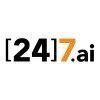


i
Dassault
Systemes
Work with us
![]()
Filter interviews by
Dassault Systemes R&D Engineer Interview Questions and Answers
32 Interview questions
JavaScript is a scripting language used for creating interactive websites and web applications.
JavaScript is a client-side scripting language, meaning it runs on the user's browser.
It is used to add interactivity, animations, and dynamic content to websites.
JavaScript can manipulate the HTML and CSS of a webpage, allowing for real-time updates and changes.
It is commonly used in conjunction with HTML and CSS to cre...
Middleware is software that acts as a bridge between different applications or systems, allowing them to communicate and share data.
Middleware facilitates communication between different software applications
It can handle tasks such as message queuing, data transformation, and security
Examples include Apache Kafka, RabbitMQ, and Microsoft BizTalk
Coin change problem involves finding the minimum number of coins needed to make a certain amount of change.
Involves finding the minimum number of coins needed to make a certain amount of change
Dynamic programming is commonly used to solve this problem
Example: If the coins available are [1, 2, 5] and the amount to make is 11, the minimum number of coins needed is 3 (5 + 5 + 1)
I would start by identifying the root cause of the crash and then work on finding a solution to fix it.
First, I would analyze the crash dump to identify the error message or code that caused the crash.
Then, I would review the software code to understand the context of the error and identify any potential bugs or issues.
I would also check for any known issues or bugs that have been reported by other customers.
Once ...
I approach conflicts by actively listening, identifying the root cause, and finding a mutually beneficial solution.
Listen to all parties involved and understand their perspectives
Identify the root cause of the conflict
Brainstorm potential solutions with all parties involved
Find a mutually beneficial solution that addresses the root cause
Communicate the solution clearly and ensure all parties are satisfied
JVM is an abstract machine that executes Java bytecode. It provides a runtime environment for Java programs.
JVM stands for Java Virtual Machine
It is responsible for interpreting the compiled Java code into machine code
JVM has three main components: class loader, runtime data area, and execution engine
The class loader loads the bytecode into the runtime data area
The runtime data area is where the JVM stores data an...
Hashmap is a data structure that stores key-value pairs and provides constant time complexity for insertion, deletion, and retrieval.
Hashmap uses a hash function to map keys to indices in an array.
Collisions can occur when two keys map to the same index, which can be resolved using techniques like chaining or open addressing.
Java provides a built-in implementation of Hashmap in the java.util package.
Example: HashM...
malloc and calloc are memory allocation functions in C. malloc allocates memory but does not initialize it, while calloc initializes memory to zero.
malloc allocates memory block of given size
calloc allocates memory block of given size and initializes it to zero
malloc returns a pointer to the allocated memory
calloc returns a pointer to the allocated memory or NULL if allocation fails
malloc does not clear the alloca...
Dynamic memory allocation in C and C++ can be done using malloc, calloc, realloc and new operators.
malloc() function is used to allocate a block of memory of specified size.
calloc() function is used to allocate a block of memory and initializes it to zero.
realloc() function is used to resize the previously allocated memory block.
new operator is used in C++ to allocate memory for an object.
Memory allocated using th...
Inheritance is a mechanism in object-oriented programming where a new class is created from an existing class.
It allows the new class to inherit the properties and methods of the existing class.
There are different types of inheritance such as single, multiple, multilevel, and hierarchical.
Single inheritance involves a child class inheriting from a single parent class.
Multiple inheritance involves a child class inh...
Dassault Systemes R&D Engineer Interview Experiences
22 interviews found
More from hacker rank
(1 Question)
- Q1. How javascript works
- Ans.
JavaScript is a scripting language used for creating interactive websites and web applications.
JavaScript is a client-side scripting language, meaning it runs on the user's browser.
It is used to add interactivity, animations, and dynamic content to websites.
JavaScript can manipulate the HTML and CSS of a webpage, allowing for real-time updates and changes.
It is commonly used in conjunction with HTML and CSS to create m...
(2 Questions)
- Q1. Basic DSA questions
- Q2. What is a middleware
- Ans.
Middleware is software that acts as a bridge between different applications or systems, allowing them to communicate and share data.
Middleware facilitates communication between different software applications
It can handle tasks such as message queuing, data transformation, and security
Examples include Apache Kafka, RabbitMQ, and Microsoft BizTalk
Skills evaluated in this interview
I applied via Campus Placement and was interviewed in Jul 2023. There were 3 interview rounds.

It consisted two sections. One was GI and other was logical
(1 Question)
- Q1. Questions on what is there in the resume, Two puzzles: bucket problem and ant problem, Which is Object oriented language from C++ and Java, Difference between C++ and Java, Why you only chose java over C++...
Interview Preparation Tips
I applied via Naukri.com and was interviewed in Dec 2022. There were 3 interview rounds.

(1 Question)
- Q1. .Introduction .Current Project Details and Roles and Responsibilities. .2 coding Problems. .Logical Question on Inheritance, Exception Handling,Strings and Basics Java and collection concepts .
(1 Question)
- Q1. . Introduction .Coding Problem .Roles and Responsibilities of the current project . Architecture Explanation of Current Project with Diagram .some Java Basic Question .HR questions
Interview Preparation Tips
There was 60mins and we have to solve 60 questions
Sometimes they take coding along with aptitude
(5 Questions)
- Q1. Most of the interview is related to the current project that i was working in the current organization.
- Q2. How to allocate dynamic memory in c n cpp
- Ans.
Dynamic memory allocation in C and C++ can be done using malloc, calloc, realloc and new operators.
malloc() function is used to allocate a block of memory of specified size.
calloc() function is used to allocate a block of memory and initializes it to zero.
realloc() function is used to resize the previously allocated memory block.
new operator is used in C++ to allocate memory for an object.
Memory allocated using these f...
- Q3. Difference between malloc and calloc
- Ans.
malloc and calloc are memory allocation functions in C. malloc allocates memory but does not initialize it, while calloc initializes memory to zero.
malloc allocates memory block of given size
calloc allocates memory block of given size and initializes it to zero
malloc returns a pointer to the allocated memory
calloc returns a pointer to the allocated memory or NULL if allocation fails
malloc does not clear the allocated m...
- Q4. What are pointers and what is dangling pointer
- Ans.
Pointers are variables that store memory addresses. A dangling pointer is a pointer that points to a memory location that has been deallocated.
Pointers are used to access memory directly
They can be used to pass values by reference
Dangling pointers can cause program crashes or unexpected behavior
- Q5. What is inheritance and its type
- Ans.
Inheritance is a mechanism in object-oriented programming where a new class is created from an existing class.
It allows the new class to inherit the properties and methods of the existing class.
There are different types of inheritance such as single, multiple, multilevel, and hierarchical.
Single inheritance involves a child class inheriting from a single parent class.
Multiple inheritance involves a child class inheriti...
(1 Question)
- Q1. This is a mix of hr and technical where they ask some puzzles and ask some basic hr question
Interview Preparation Tips
Skills evaluated in this interview
I appeared for an interview before Aug 2023.
Basic HTML, CSS and JS questions
(1 Question)
- Q1. Aptitude & Logical questions and JS questions
(1 Question)
- Q1. Normal discussions
Interview Preparation Tips
- Javascript
- HTML
- React.Js
- CSS
I applied via Naukri.com and was interviewed before May 2023. There were 5 interview rounds.
General Aptitude test along with Coding Test.
(1 Question)
- Q1. Basic Javascript Questions and outputs of code snippet.
(1 Question)
- Q1. Scenario based Question along with some puzzle
(1 Question)
- Q1. Behavioural Questions
(1 Question)
- Q1. Salary discussion
Interview Preparation Tips
I applied via Approached by Company and was interviewed before Apr 2023. There were 3 interview rounds.
This was my 1st round in which aptitude question.
(1 Question)
- Q1. Asked about closers in Javascript. One Aptitude question And one output realted question in javascript
(1 Question)
- Q1. Puzzles were asked in this round related to a sandclock.
I applied via Campus Placement and was interviewed before Apr 2023. There were 2 interview rounds.
(1 Question)
- Q1. C++ specific interview
(1 Question)
- Q1. Explain coin change problem ?
- Ans.
Coin change problem involves finding the minimum number of coins needed to make a certain amount of change.
Involves finding the minimum number of coins needed to make a certain amount of change
Dynamic programming is commonly used to solve this problem
Example: If the coins available are [1, 2, 5] and the amount to make is 11, the minimum number of coins needed is 3 (5 + 5 + 1)
Interview Preparation Tips
- IT Projects
- C++
- Algorithms
- Datastructures
Skills evaluated in this interview
I applied via Company Website and was interviewed before Apr 2023. There were 2 interview rounds.
Contains Maths/Apti and basic coding question
(1 Question)
- Q1. Asked about OOPs Concept, Geometry and Puzzle
Top trending discussions






Dassault Systemes Interview FAQs
Some of the top questions asked at the Dassault Systemes R&D Engineer interview -
The duration of Dassault Systemes R&D Engineer interview process can vary, but typically it takes about less than 2 weeks to complete.
Tell us how to improve this page.
Dassault Systemes Interviews By Designations
- Dassault Systemes R&D Engineer Interview Questions
- Dassault Systemes Software Engineer Interview Questions
- Dassault Systemes Software Developer Interview Questions
- Dassault Systemes QA Engineer Interview Questions
- Dassault Systemes Software Engineering Specialist Interview Questions
- Dassault Systemes Senior Software Engineer Interview Questions
- Dassault Systemes Java Developer Interview Questions
- Dassault Systemes Research and Development Interview Questions
- Show more
Interview Questions for Popular Designations
Overall Interview Experience Rating
based on 11 interview experiences
Difficulty level
Duration
Top Skills for Dassault Systemes R&D Engineer
Interview Questions from Similar Companies
Dassault Systemes R&D Engineer Reviews and Ratings
based on 92 reviews
Rating in categories
|
R&D Engineer
634
salaries
| ₹9.2 L/yr - ₹19.9 L/yr |
|
Software Engineering Specialist
425
salaries
| ₹9 L/yr - ₹16 L/yr |
|
Software Developer
351
salaries
| ₹9.2 L/yr - ₹16.6 L/yr |
|
Software Engineer
324
salaries
| ₹9 L/yr - ₹16 L/yr |
|
QA Engineer
137
salaries
| ₹7.9 L/yr - ₹13.5 L/yr |

Autodesk

Oracle

Amdocs

Automatic Data Processing (ADP)
- Home >
- Interviews >
- Dassault Systemes Interview Questions













